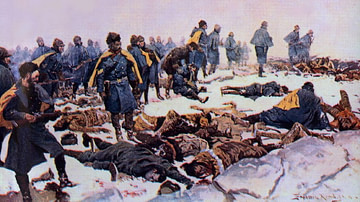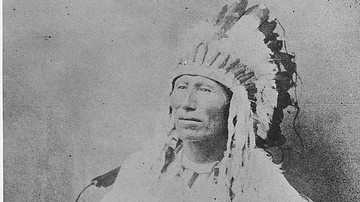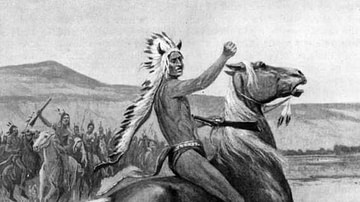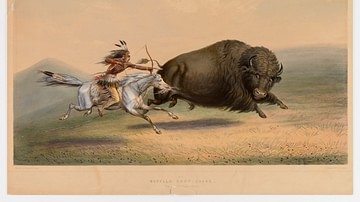Falling Star is a Cheyenne tale of the great hero Hotoketana'ohtse ("Falling Star") who came from the heavens to stand up for those who could not defend themselves, slay monsters, and save the people from starvation. The hero-from-heaven figure features in many Native American tales of different nations, but Falling Star is among the best-known and frequently anthologized.
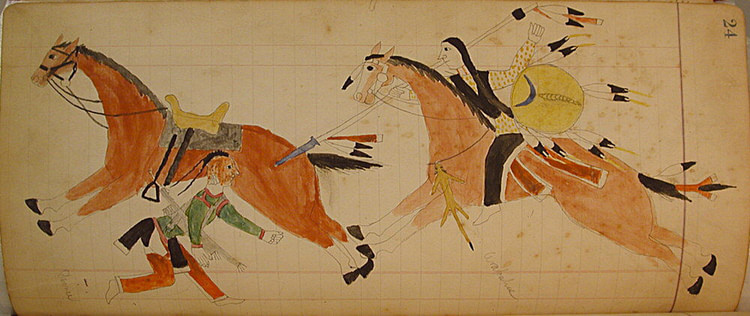
The story shares similarities with the hero tales of cultures around the world as it focuses on a central character of supernatural origin who is raised far from home and comes to the people in a time of need to save them from danger or destruction or to offer them the promise of renewal and redemption. In this version of the hero tale, the main character's mother is a young Cheyenne maiden who falls in love with Brightest-Star (the evening and morning star) and marries him, joining him in his heavenly home. As in many myths, the young woman is told she may go anywhere and do anything she likes but is prohibited from engaging in a certain action or going to a certain place; in this case, digging roots near the prairie turnips with the great green tops.
Her curiosity about this area gets the better of her, however, and when she digs there, she opens a hole in the heavens and can see the village she left behind far below her. Homesick, she braids a rope and climbs down but falls and is killed. Her unborn child, though, lives and is rescued by the kind honoxease ("western meadowlark"), who brings the child back to its nest, raising him as one of its own. When the child has grown, the meadowlark sends him back to the people of his mother, where he becomes their champion and a great hero.
Similarities with Other Native American Tales
The story's details are similar to the Lakota Sioux tale of the hero Wicahpi Hinhpaya ("Fallen Star" in the Sioux language), who also falls from heaven with his mother (though as a newborn) and becomes the champion of the people. He famously rescues a group of girls from hungry bears by raising the patch of earth they are on high above the bears' reach and then has them flown back to their relatives by flocks of birds. The great earthen mound he raised can still be seen today, known by the Lakota as Mato Tipila "the Lodge of Bears" and by Americans as Devil's Tower, the famous butte and national monument in Wyoming.
In some ways, the story is also similar to the Cheyenne story of the antihero/trickster figure Sweet Medicine who becomes a great prophet and foundational figure. Unlike Falling Star, Sweet Medicine first appears as a plague to his people, generally causing trouble, killing a powerful chief, taking away the buffalo, and vanishing into his home of the spirit world when threatened. When he returns, however, he has matured, repents of his earlier behavior, and establishes the ceremony to bring back the buffalo, which becomes the Sun Dance. Afterwards, he remains as a prophet and champion to his people, like Falling Star, until his death. Sweet Medicine is credited with giving the Cheyenne the Four Sacred Arrows, which are still used in traditional rituals in the present day.
Among the many other star-hero or spirit-hero tales of Native American nations, Falling Star also shares similarities with the Hocak (Ho-Chunk) Winnebago and the Ioway nations' legends of Red Horn, who, like these other heroes, champions the cause of the weakest creatures on earth – the two-legged humans – as well as those who are considered least among them.






Twelve Stories of the Plains Indians
Text
The story first appears in the works of the anthropologist/folklorist George Bird Grinnell (l. 1849-1938) in 1900 in the Journal of American Folklore, issue 34. The text below is an abbreviated version from Voices of the Winds: Native American Legends by Margot Edmonds and Ella Clark. A fuller version of the tale is given in the bibliography following the article from the Cheyenne website Honoxease.
As with most Native American tales, however, there are many versions of the same story. Scholar Larry J. Zimmerman writes:
The stories of heroes and tricksters are kept alive through the spoken word. Narratives are recounted in both religious and secular settings, and although they tell of a sacred time, they by no means constitute an inflexible liturgy that is rigid in form and content. Versions may differ substantially in detail. (202)
The versions of the story of Falling Star – by whatever name he is given by different Native American nations – follow this same paradigm, and even within the Cheyenne nation, there are many different details added in a given recitation of the story. As with almost all Native American tales, no date can be given to the origin of the story because it was passed down orally for generations. Any time it was told, the storyteller might weave another episode into the narrative, accounting for the many different versions of the same tale eventually set down in writing by the Euro-Americans.
One day in the long ago, two young Indian girls were lying on the grass outside their tepee on a warm summer evening. They were looking up into the sky, describing star-pictures formed by their imaginations.
"That is a pretty star. I like that one," said First Girl.
"I like that one best of all–over there," Second Girl pointed.
First Girl pointed to the brightest star in the sky and said, "I like the brightest one best of all. That is the one I want to marry."
That evening they agreed to go out the next day to gather wood. Next morning, they started for the timbered area. On their way they saw a porcupine climb a tree.
"I'll climb the tree and pull him down," said First Girl. She climbed but could not reach the porcupine.
Every time she stretched her hand for him, the porcupine climbed a little higher. Then the tree started growing taller. Second Girl below called to her friend, "Please come down, the tree is growing taller!"
"No," said First Girl as the porcupine climbed higher and the tree grew taller. Second Girl could see what was happening, so she ran back to the camp and told her people. They rushed to the tree, but First Girl had completely disappeared!
The tree continued to grow higher and higher. Finally, First Girl reached another land. She stepped off the tree branch and walked upon the sky! Before long she met a kindly looking middle-aged man who spoke to her. First Girl began to cry.
"Whatever is the matter? Only last night I heard you wish that you could marry me. I am the Brightest-Star," he said.
First Girl was pleased to meet Brightest-Star and became happy again when she got her wish and married him. He told her that she could dig roots with the other star-women, but to beware of a certain kind of white turnip with a great green top. This kind she must never dig. To do so was "against the medicine"- against the rules of the Sky-Chief.
Every day First Girl dug roots. Her curiosity about the strange white turnip became so intense that she decided to dig up one of them. It took her a long, long time. When she finally pulled out the root, a huge hole was left. She looked into the hole and far, far below she saw the camp of her own people.
Everything and everyone was very small, but she could see lodges and people walking. Instantly she became homesick to see her own people again. How could she ever get down from the sky? She realized it was a long, long way down to earth. Then her eyes fell upon the long tough grass growing near her. Could she braid it into a long rope? She decided to try, every day pulling more long grass and braiding more rope.
One time her husband Brightest-Star asked, "What is it that keeps you outdoors so much of the time?"
"I walk a great distance and that makes me tired. I need to sit down and rest before I can start back home."
At last, she finished making her strong rope, thinking by now it must be long enough. She tied one end of the rope to a log that she rolled across the top of the hole as an anchor. She let down the rope. It looked as though it touched the ground.
She lowered herself into the hole, holding onto the braided rope. It seemed to take a long time as she slowly lowered herself until she came to the end of the rope. But it did not touch the earth! For a long while she hung on dangling in midair and calling uselessly for help. When she could hold on no longer, she fell to the ground and broke into many pieces. Although she died, her unborn son did not die, because he was made of star-stone and did not break.
A meadowlark saw what happened and took the falling-star baby to her nest. There the lark kept him with her own baby birds. When they were older, Falling-Star crept out of the nest with the little birds. The stronger the birds grew, the stronger grew Falling-Star. Soon all of them could crawl and run. The young birds practiced their flying while Falling-Star ran after them. Then the young birds could fly anywhere they wished, while Falling-Star ran faster and faster to keep up with them.
"Son, you had better go home to your own people," said Mother Meadowlark. "It is time for us to fly south for the winter. Before long, the weather here will be very cold."
"Mother Meadowlark," asked Falling-Star. "Why do you want me to leave you? I want to go with you."
"No, Son," she replied. "You must go home now."
"I will go if Father Meadowlark will make me a bow and some arrows."
Father Meadowlark made a bow and pulled some of his own quills to feather the arrows. He made four arrows and a bow for Falling- Star. Then he started Falling-Star in the right direction toward his home, downstream.
Falling-Star travelled a long time before he reached the camp of his people. He went into the nearest lodge owned by an old grandmother.
"Grandmother," he said. "I need a drink of water."
"My grandson," she said to him, "only the young men who are the fastest runners can go for water. There is a water-monster who sucks up any people who go too close to it."
"Grandmother, if you will give me your buffalo-pouch and your buffalo-horn ladle, I will bring you water."
"Grandson, I warn you that many of our finest young men have been destroyed by the water-monster. I fear that you will be killed, too." But she gave him the things he asked for. He went upstream and dipped water, at the same time keeping watch for the monster.
At the very moment Falling-Star filled his bucket, the water-monster raised its head above the water. His mouth was enormous. He sucked in his breath and drew in Falling-Star, the bucket, water, and the ladle. When Falling-Star found himself inside the monster's stomach, he saw all the other people who had ever been swallowed. With his star-stone, he cut a hole in the animal's side. Out crawled all the people and Falling-Star rescued his pouch and ladle for his grandmother, taking her some cool, fresh water.
"My grandson, who are you?" she asked, marveling at his survival.
"Grandmother, I am Falling-Star. I killed the monster who has caused our people much suffering, and I rescued all the people who had been swallowed."
The old woman told the village crier to spread the good news that the monster was dead. Now that Falling-Star had saved the camp people there, he asked the grandmother, "Are there other camps of our people nearby?"
"Yes, there is one farther downstream," she said.
Falling-Star took his bow and arrows and left camp. The fall of the year had now arrived. After travelling many days, he reached the other camp. Again, he went into an old woman's lodge where she sat near her fire.
"Grandmother, I am very hungry," he said.
"My son, my son, we have no food. We cannot get any buffalo meat. Whenever our hunters go out for buffalo, a great white crow warns the buffalo, which drives them away.
"How sad," he said. "I will try to help. Go out and look for a worn-out buffalo robe with little hair. Tell your chief to choose two of his fastest runners and send them to me."
Later, the old woman returned with the robe and the two swift runners. Falling-Star told them his plan. "I will go to a certain place and wait for the buffalo. When the herd runs, I will follow, disguised as a buffalo in the worn-out robe. You two runners chase me and the buffalo for a long distance. When you overtake me, you must shoot at me. I will pretend to be dead. You pretend to cut me open and leave me there on the ground."
When the real buffalo arrived, the white crow flew over them screaming, "They are coming! They are after you! Run, run!" The buffalo herd ran, followed by a shabby-looking bull.
The two swift runners chased the old bull according to plan. All kinds of birds, wolves, and coyotes came toward the carcass from all directions. Among them was the white crow. As he flew over Falling-Star in disguise, he called out shrilly, "I wonder if this is Falling-Star?"
Time after time the crow flew over the carcass, still calling, "I wonder if this is Falling-Star?" He came closer and closer with each pass. When he was close enough, Falling-Star sprang and grabbed the legs of the white crow. All of the other birds and animals scattered in every direction.
When Falling-Star brought the captive white crow home to the grandmother, she sent word for the chief.
"I will take the white crow to my lodge. I will tie him to the smoke hole and smoke him dead," said the chief.
From that moment on, the good Cheyenne were able to kill many buffalo and they had plenty of buffalo meat for all their needs.
The people in gratitude gave Falling-Star a lovely lodge-home and a pretty Indian maiden waiting there to become his wife. They remained all of their lives with the Northern Cheyenne Indian tribe.
